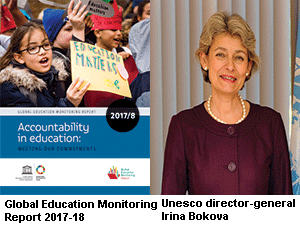 Among the major recommendations of the Global Education Monitoring (GEM) Report 2017-18 released on October 24 in Paris by Unesco, are a call upon governments to design accountability systems for schools and teachers that are supportive of children and avoid punitive mechanisms especially those based on narrow performance measures, allow for democratic participation, respect media freedom to scrutinise education, and establish independent institutions to hear complaints.
Among the major recommendations of the Global Education Monitoring (GEM) Report 2017-18 released on October 24 in Paris by Unesco, are a call upon governments to design accountability systems for schools and teachers that are supportive of children and avoid punitive mechanisms especially those based on narrow performance measures, allow for democratic participation, respect media freedom to scrutinise education, and establish independent institutions to hear complaints.
The 505-page annual GEM Report sub-titled Accountability in Education, Meeting our Commitments, second in the series that focuses on accountability, is “the mechanism for monitoring and reporting on SDG (Sustainable Development Goals) 4 on education in the other SDGs”. The SDGs were adopted by 193 member countries of the United Nations in 2015 as successors of the Millennium Development Goals ratified by UN member countries in the Millennium Declaration (2000) and whose timeline expired in 2015. The SDGs officially known as ‘Transforming our World: the 2030 Agenda for Sustainable Development’ has set 17 global goals and 169 targets. Among them: improving health and education, making cities more sustainable, combating climate change and protecting oceans and forests.
Use of the word ‘accountability’ throughout the 2030 agenda’s framework for action, demonstrates the high importance that Unesco accords to follow up and review functions to catalyse and monitor progress. This also means that all countries should produce national education monitoring reports explaining their progress against their commitments — currently only about half do so and most of them not regularly (India is among the countries which don’t publish such a report). “Accountability is about interpreting evidence, identifying problems and working out how to solve them. This must be the backbone to all our efforts to achieve equitable, high-quality education for all,” writes Irina Bokova, Unesco’s director-general in the foreword.
Against the backdrop of calls for linking teachers’ pay to students’ academic performance in examinations in this country, the report stresses that blaming teachers for poor student test scores and absenteeism is unjust and unconstructive. “Using student test scores to sanction teachers and schools makes it more likely they will adjust their behaviour to protect themselves, which may mean leaving the weakest learners behind,” warns Manos Antoninis, director of GEM 2017. “Accountability must start with governments. If a government is too quick to apportion blame to others, it is deflecting attention away from its own responsibility for creating a strong, supportive education system,” he adds.
Setting and enforcing regulations ranging from contract tendering to teacher qualifications are also crucial, says the report. Fewer than half of low and middle-income countries had standards for early childhood education and only a handful had mechanisms to monitor compliance. There are no regulations of class sizes in almost half the countries, and government regulations are often too slow to keep up with the fast growth of private schools and universities.
The establishment of an International Finance Facility for Education, initially proposed by the International Commission on Financing Global Education Opportunity, received a boost when a reference to it was included in the G20 Leaders’ Declaration at the July 2017 summit in Hamburg. Its aim would be to expand the capacity of development banks to lend to lower middle income countries.
Though the report isn’t country specific, yet it has brief mentions on some best and worst practices/interventions in various countries. On India, GEM 2017 has some specific observations. It acknowledges that following a Supreme Court ruling, since 2003 government agencies have started producing extensive content on environmental education, which has resulted in over 300 million students in 1.3 million schools receiving some environmental education training. It also talks about how right to food litigation brought before the Indian Supreme Court, prompted an additional 350,000 girl children to attend school. It also notes how India’s Aakash tablet project, a public-private partnership, was a disaster due to inadequate government enforcement, which ended up primarily benefiting the vendor. “A right to information request revealed that the programme eventually met an initial target of 100,000 tablets and was wound down quietly in March 2015. While only some Indian students received subsidised tablets, DataWind ended up a big winner,” write the authors of GEM 2017.
GEM 2017 also supports the repeated calls of your editors for larger outlays for public education which isn’t supported by most economists — including Swaminathan Aiyar of the Times of India — who believe inefficiency rather than inadequacy of the annual budgetary outlays of the Central and state governments is the major problem. It has asked governments to ensure expenditure of at least 4 percent of GDP or 15 percent of total annual government expenditure on education.
“The report has made a very good set of recommendations which are very relevant to India. Given the weak accountability and monitoring mechanisms that we have here, the report has cogently argued that education is primarily the responsibility of the State and we all need to make the government understands that. GEM 2017 couldn’t have come at a better and more opportune time when the New Education Policy formulation process is in progress. This report has also given publicity to some good international examples and the government and all educationists can take some useful lessons from them,” says Anjela Taneja, technical director of education at CARE India, an international NGO which focuses on poverty alleviation and social exclusion issues including education.
Autar Nehru (Delhi)